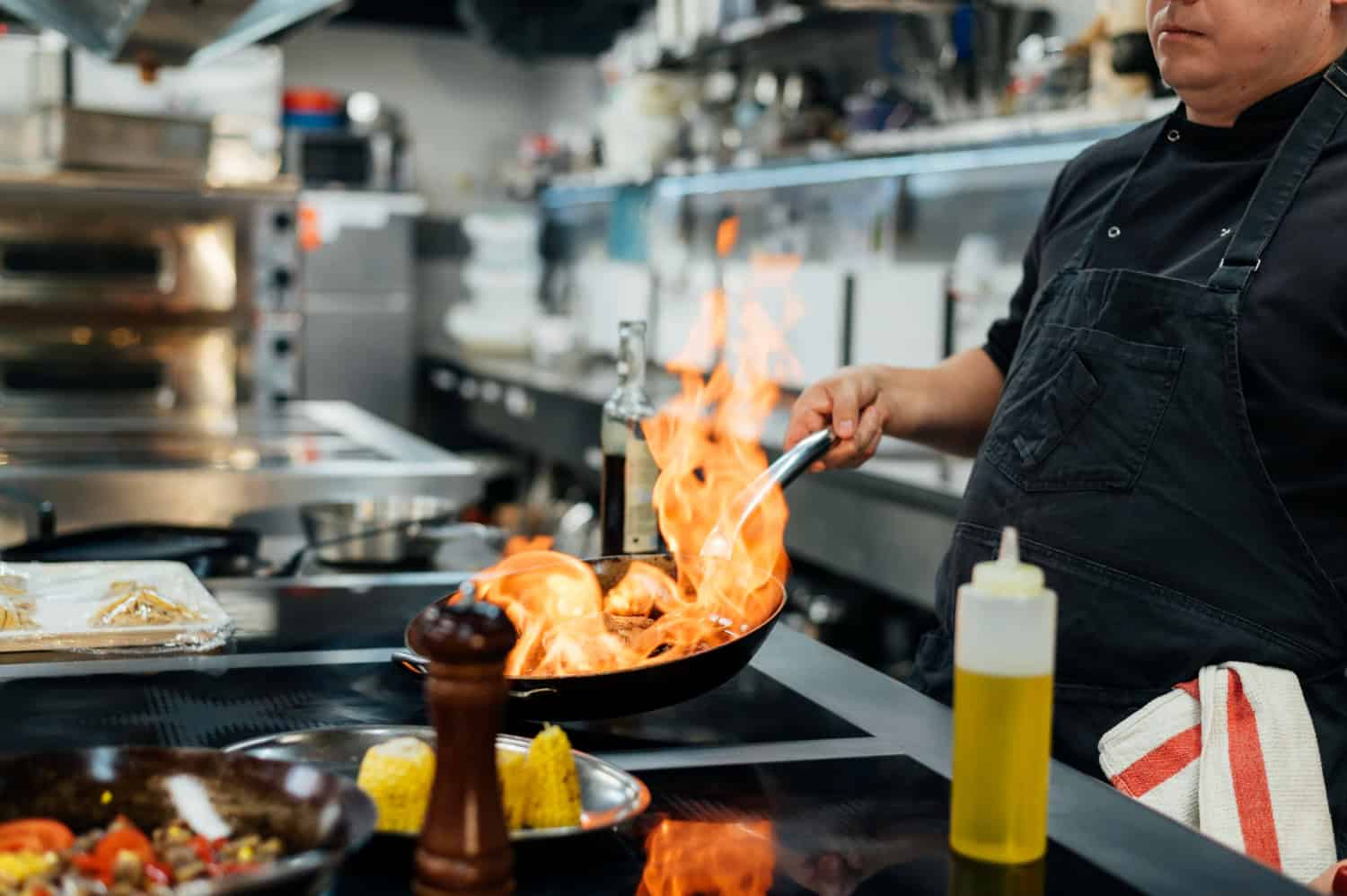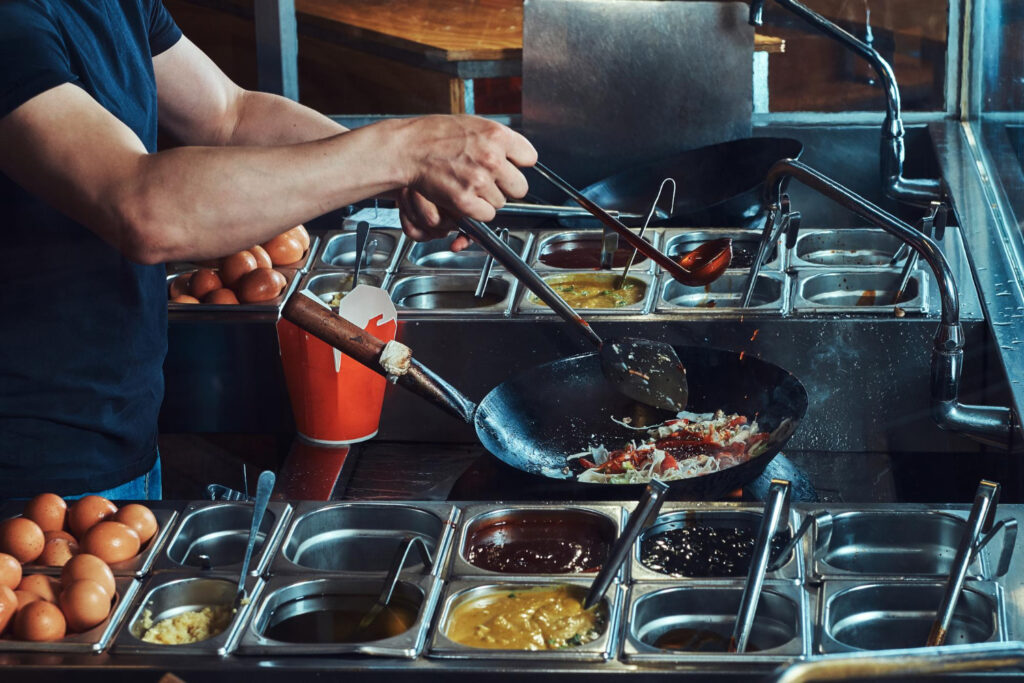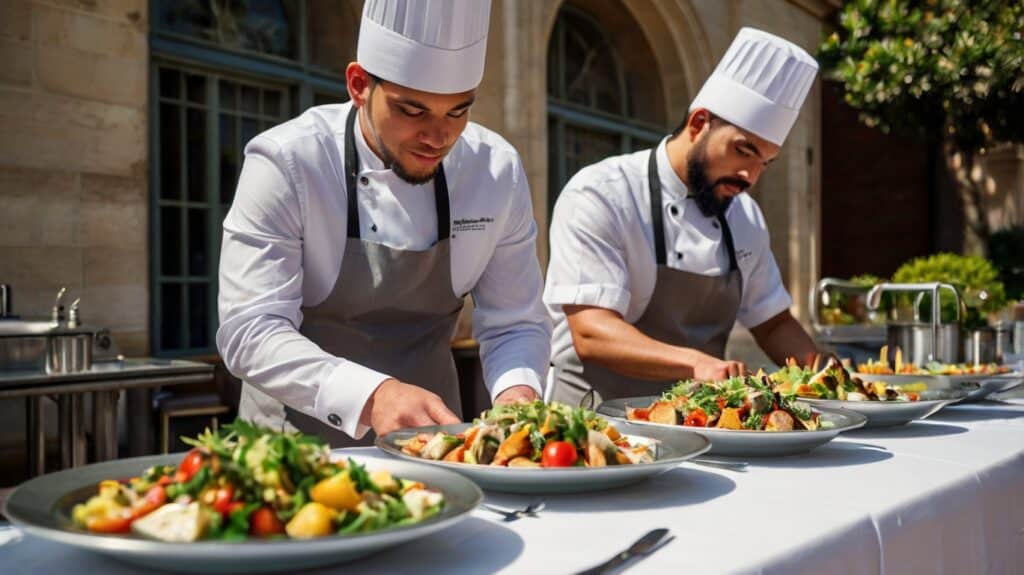
By Jermaine Thomas June 30, 2025
Today dining is about so much more than just filling a plate. In a world where experiences are worth more than objects, food presentation has become entertainment, storytelling and connection. One of the biggest trends driving this change is the rise of live stations and interactive catering.
These live stations do more than feed a crowd. They stimulate the eyes, ears, nose and taste buds, a full on experience that draws people into the food making process. Whether it’s a sizzling grill at a wedding or a fresh pasta bar at a corporate event, interactive catering is turning events into sensory journeys.
The Rise of Experiential Dining
In the past, catering often followed a predictable format. Food was prepared behind the scenes, plated in bulk, and served from chafing dishes. While this method was efficient, it lacked excitement. Today’s guests crave more. They want to see, hear, and interact with their food as it is made. This shift has given rise to interactive catering ideas that break the barrier between chef and diner. Guests don’t just receive a meal. They witness the process, ask questions, and sometimes even participate in the final touches.
As the food and events industry becomes more experience-focused, live cooking stations have grown from novelty features to event highlights. They represent creativity, craftsmanship, and a personal touch that mass catering simply cannot deliver.

Why Engaging the Senses Matters
Humans experience food through all five senses. We hear the crackle of oil in a pan, see steam rise from freshly cooked dishes, smell fragrant herbs, feel the texture of food in our hands or on our tongues, and of course, savor the taste. Each of these sensory cues contributes to our enjoyment and memory of a meal.
Live cooking stations maximize this multisensory potential. The chef’s movements, the colorful ingredients, the sizzling sounds, and the aroma of freshly prepared food combine to create an emotional and physical connection to the meal. This immersive quality makes guests feel like more than spectators. They become participants in the meal’s creation.
By offering a sensory dining experience, caterers can elevate even simple dishes into memorable moments. When people remember the meal, they also remember the event and the brand or host behind it.
Visual Appeal: The First Connection
When guests approach a live cooking station, sight is the first sense to be engaged. The colours of the ingredients, the movement of the chef and the arrangement of the tools draw them in. A well designed station becomes a visual anchor in the space and grabs attention and curiosity.
Chefs play into this by showcasing ingredients in an artistic way – stacked vegetables, layered meats, vibrant sauces and fresh garnishes arranged like art. The performance aspect adds drama – dough being tossed in the air or flames leaping from a grill, it’s a show.
This visual storytelling sets the tone for the rest of the sensory experience. It says quality, attention to detail and personalisation that feels luxurious and real.
Sound: Creating Anticipation
Sound may be one of the most underrated elements in food service, but it plays a powerful role in setting the mood. The hiss of a hot skillet, the rhythmic chopping of vegetables, or the bubbling of a simmering pot all create anticipation and excitement.
In a live cooking station, sound is part of the performance. It indicates freshness and action. Guests hear their meal coming to life, which builds suspense and engagement. The soundtrack of food being prepared adds a unique texture to the event atmosphere that static catering tables simply cannot replicate.
In many cases, sound also signals interaction. Guests may hear chefs explaining ingredients or offering preparation tips. This dialogue adds a human element that makes the experience more personal.
Smell: Triggering Memory and Hunger
Of all the senses, smell is the most connected to memory. A certain scent can transport someone to another time or place. In catering this is especially powerful. Live cooking stations fill the room with the smell of herbs, spices and freshly cooked food. This smell draws guests in before they even see the food. It stimulates appetite, curiosity and sense of occasion.
Pre-prepared food may be covered or reheated in warming trays. Freshly made food offers real time olfactory engagement. The smell of garlic sizzling in oil or crepes cooking on a hot plate speaks to authenticity and freshness. When you want to deliver a full sensory dining experience, smell is not just a detail. It’s a key part of the emotional journey.
Touch and Texture: Interactivity Builds Connection
Touch is often overlooked in dining, especially in formal events. But texture and tactile interaction deepen guest engagement. Some interactive catering ideas invite guests to touch ingredients, shape dough, or garnish their dishes. Even when guests are not physically preparing the food, they still feel involved. Watching the chef knead dough or roll sushi offers vicarious sensory stimulation. The texture of a warm crepe or crispy taco shell handed directly from the chef adds intimacy to the meal.
These touchpoints create personal connection. They move the experience from passive to active, making the meal feel more like a collaboration than a transaction.
Taste: The Culmination of the Experience
Of course, taste is the final and most important sensory checkpoint. After seeing, smelling, and hearing the food, the guest finally tastes the result. And here, live cooking stations shine once more. Freshly cooked food simply tastes better. The timing, temperature, and customization possible in live service ensure that the dish is delivered at its peak. Guests can choose spice levels, toppings, or sauces according to preference, making the experience even more satisfying.
The memory of taste lingers. And when combined with all the other senses, it becomes a powerful recall tool. Guests are far more likely to remember and talk about meals that engaged them on every level.
Customization and Guest Empowerment
Another big benefit of live cooking stations is customization. Unlike buffets or plated meals, guests can choose what goes in their dish. This increases satisfaction and accommodates dietary restrictions, allergies and preferences more easily. Customization makes the guest feel empowered. They feel seen and heard. Whether they’re choosing ingredients for a stir-fry or building their own pizza, they own their meal.
This is what turns a meal into a memory. In a crowded event space, giving guests a say in their dining experience makes your brand or event stand out.
Interactive Catering Ideas Across Event Types
Interactive catering ideas work across all event formats. For weddings, pasta or taco bars are fun and personal. For corporate events, action stations like made-to-order sandwiches or wok stations keep guests engaged during networking. For festivals and outdoor events, visual spectacle like rotisserie grills or crepe stands are a winner. For smaller gatherings, dessert stations where guests decorate cupcakes or build sundaes are playful and inclusive.
Whatever the occasion, the goal is the same: make the event more meaningful through multi-sensory food interaction.
Branding Through Culinary Experience
For businesses and organizations, live cooking stations also offer branding potential. Logos can appear on chef aprons, signage, or even edible components like custom-printed macarons. More importantly, the overall experience of quality, creativity, and engagement reflects positively on the brand itself. Brands known for innovation, wellness, hospitality, or craftsmanship can reinforce those messages through food presentation. The way guests feel during the sensory dining experience transfers to their impression of the company.
When done well, these touchpoints become a form of soft marketing. Guests share their experiences on social media, talk about the event afterward, and associate the host with quality and attention to detail.

Logistical Considerations for Live Stations
Of course, a great live cooking station experience requires planning. Event organizers need to think about space, ventilation, equipment and guest flow. Stations should be placed where they are easily accessible but not in the way. Timing is key too. Stations should be ready to go when guests arrive and designed to minimize wait times. Using experienced chefs and well trained staff ensures a smooth operation and consistent quality.
Sanitation, safety and communication need to be managed too. When the logistics are seamless the experience feels effortless and guests can focus on enjoying the meal.
Making It Scalable and Affordable
Some event planners think interactive catering is only for big budgets. But with smart planning even small events can have sensory food experiences. Offering one well executed station instead of multiple generic buffet options elevates the whole event. Partner with local chefs, use seasonal ingredients and focus on a few standout dishes and costs are manageable. Smaller stations or chef led demos can give many of the same benefits as full service live stations.
The return on investment in terms of guest satisfaction, brand perception and event memorability far outweighs the extra cost.
Conclusion
Food today is a sensory experience, not just sustenance. Live cooking stations and interactive catering transform events by engaging all five senses, creating memorable, immersive dining moments. From weddings to corporate gatherings, personalized food presentations add excitement and authenticity, making meals more than just meals; they become unforgettable experiences.